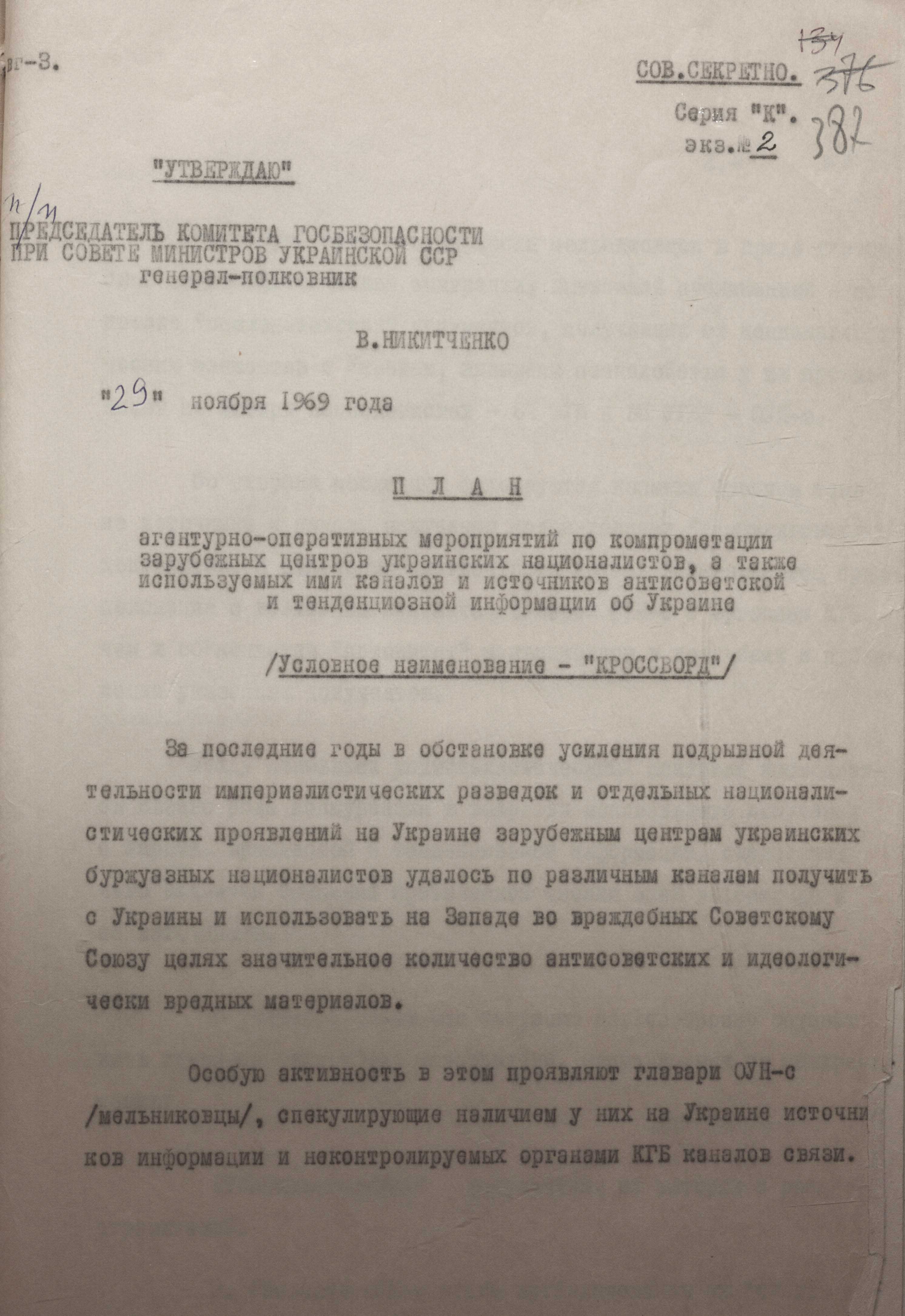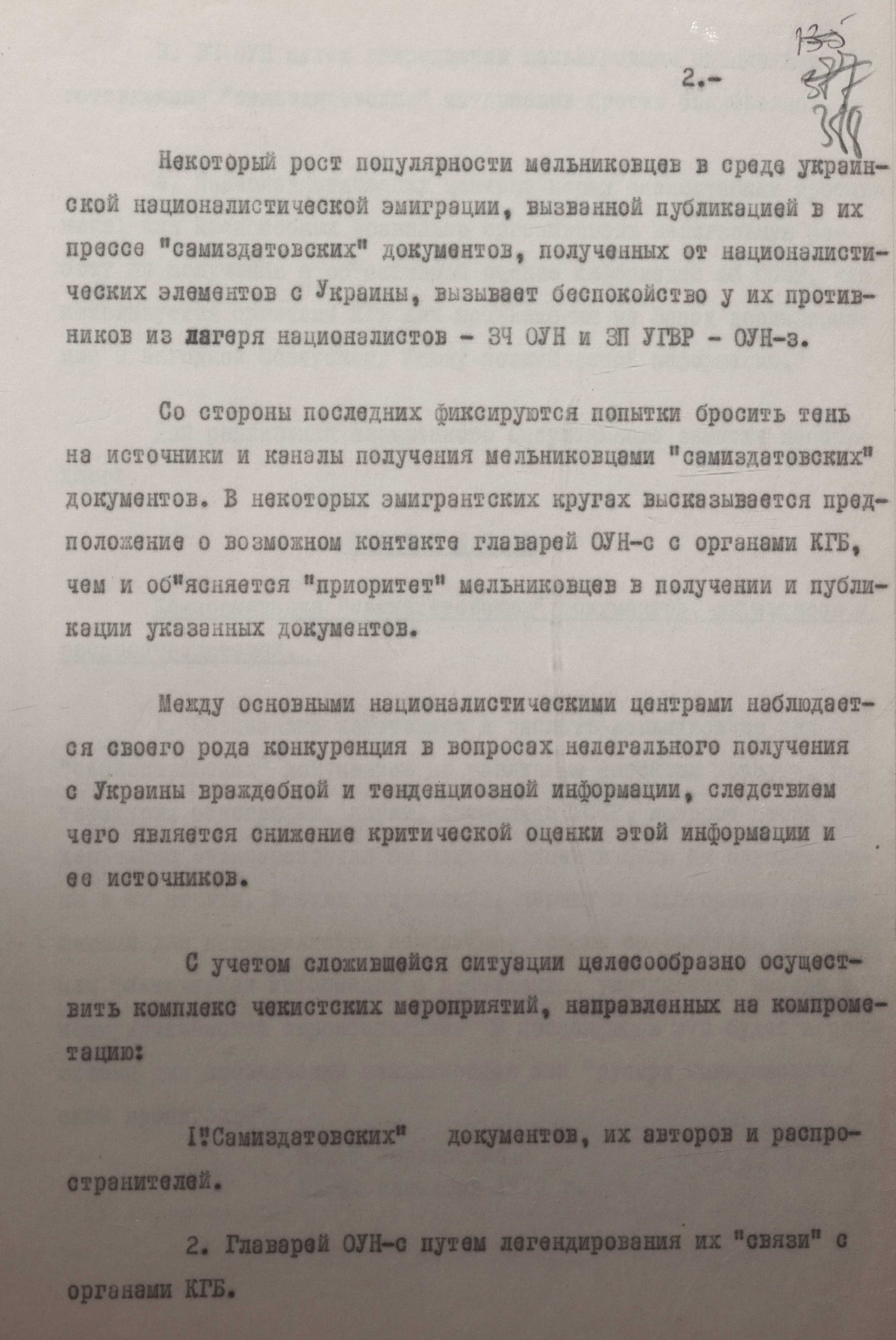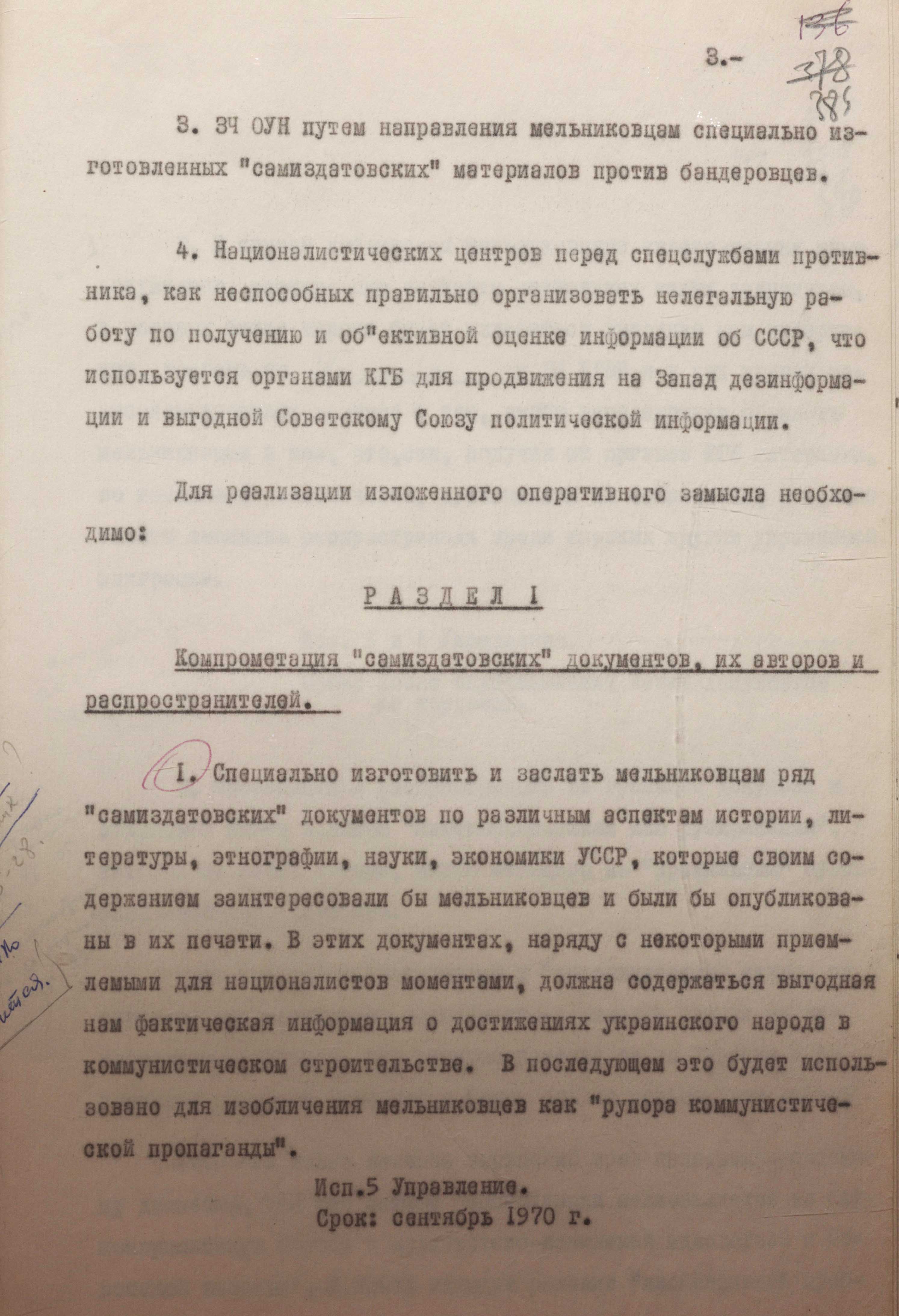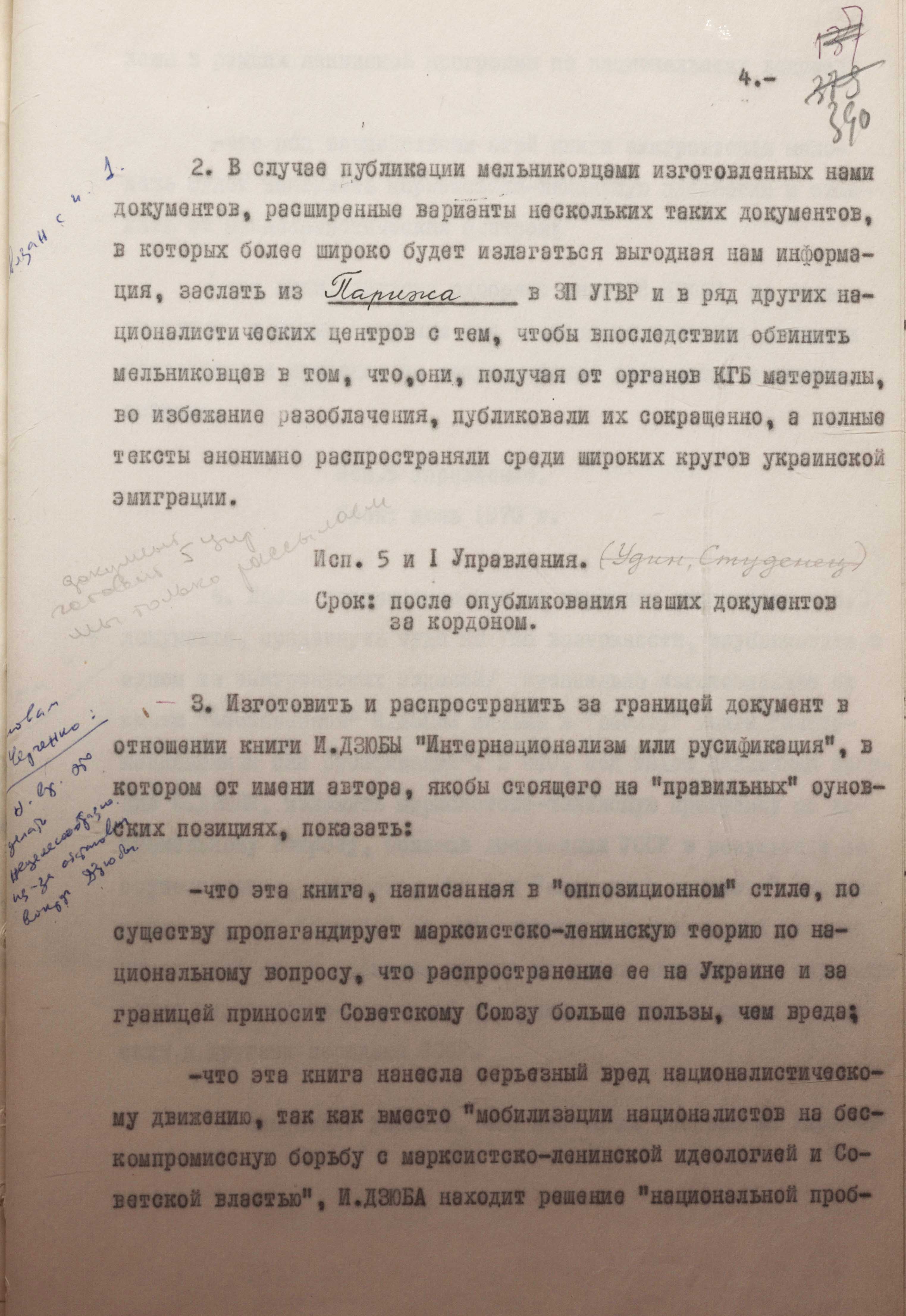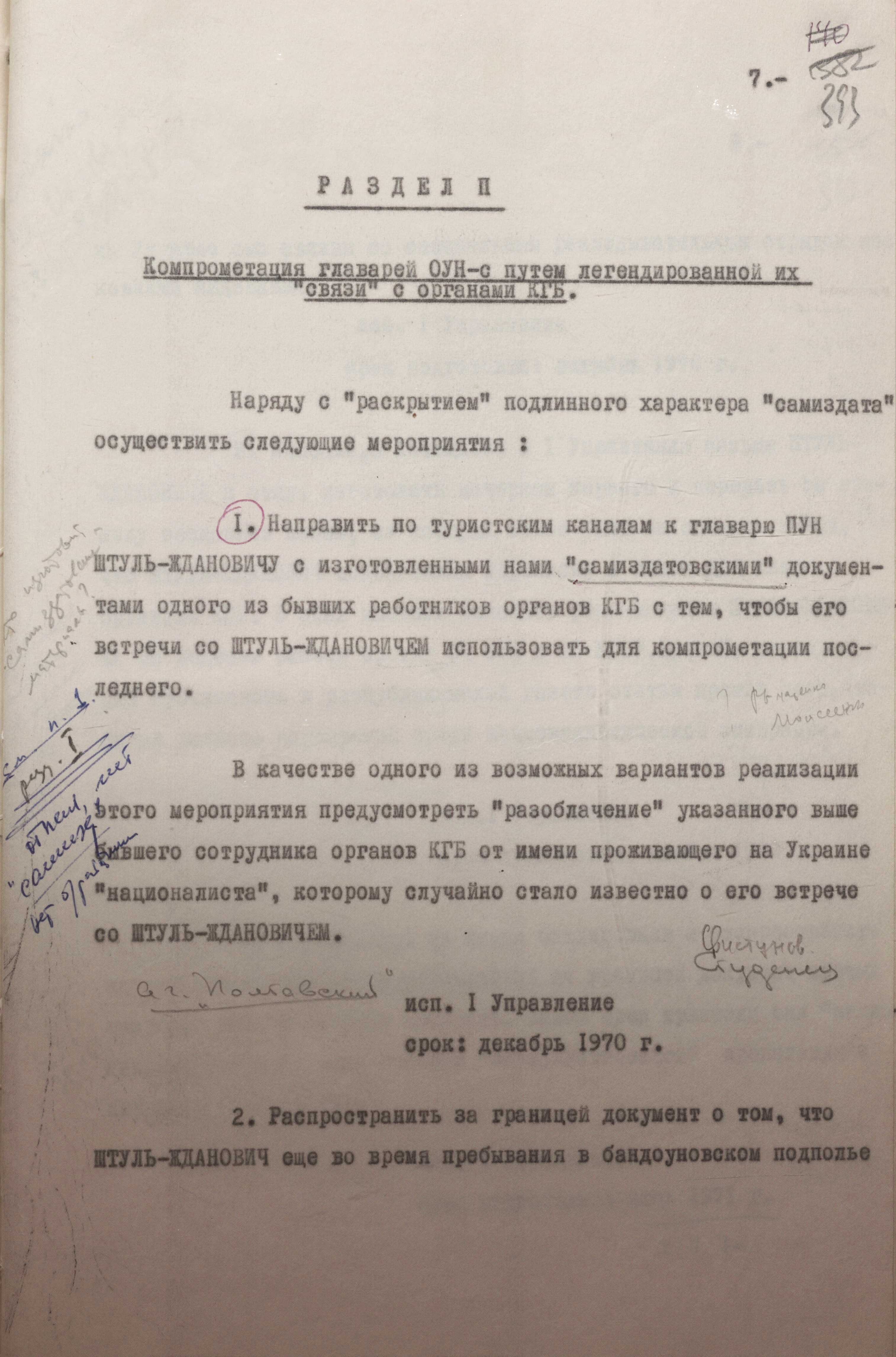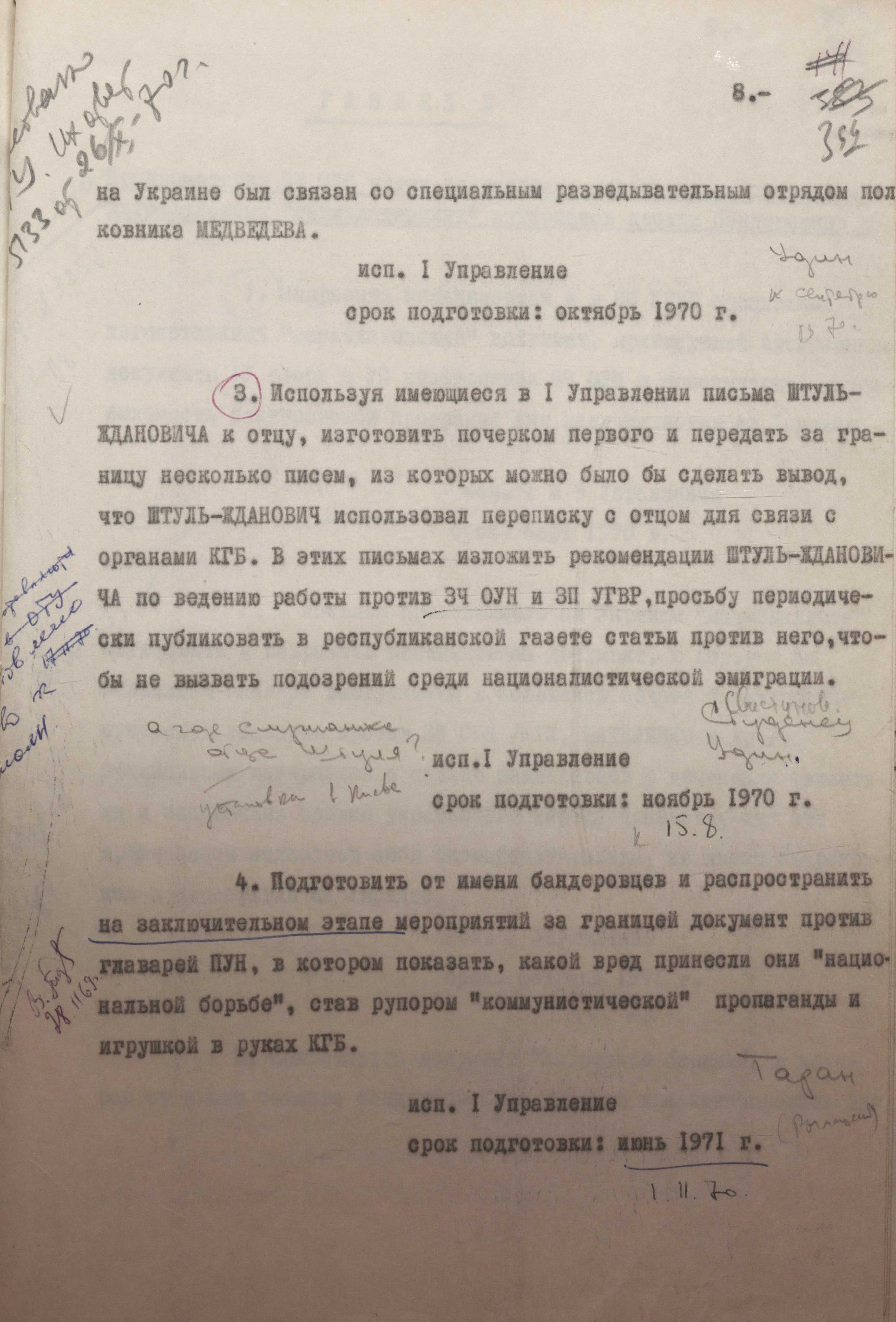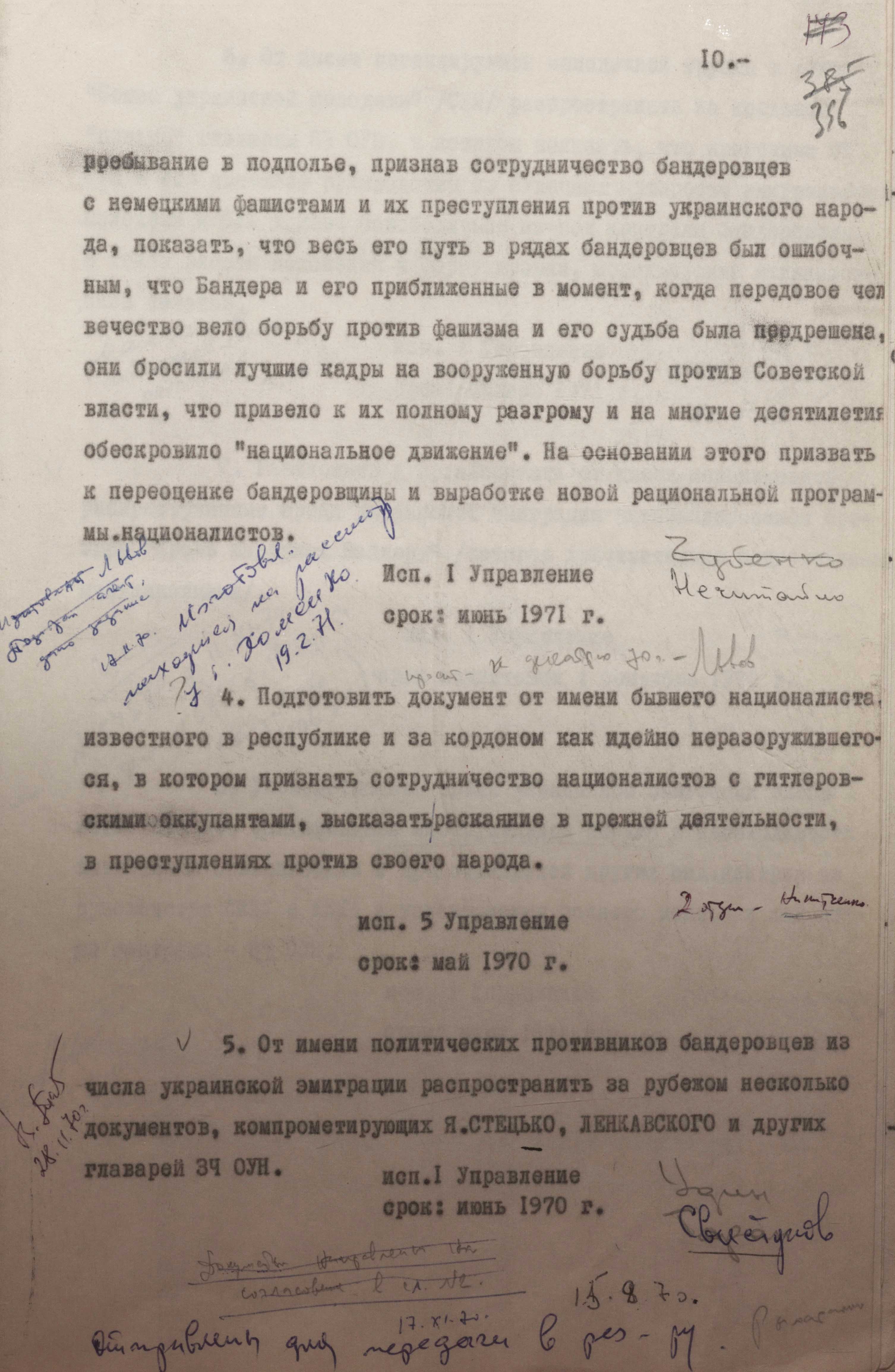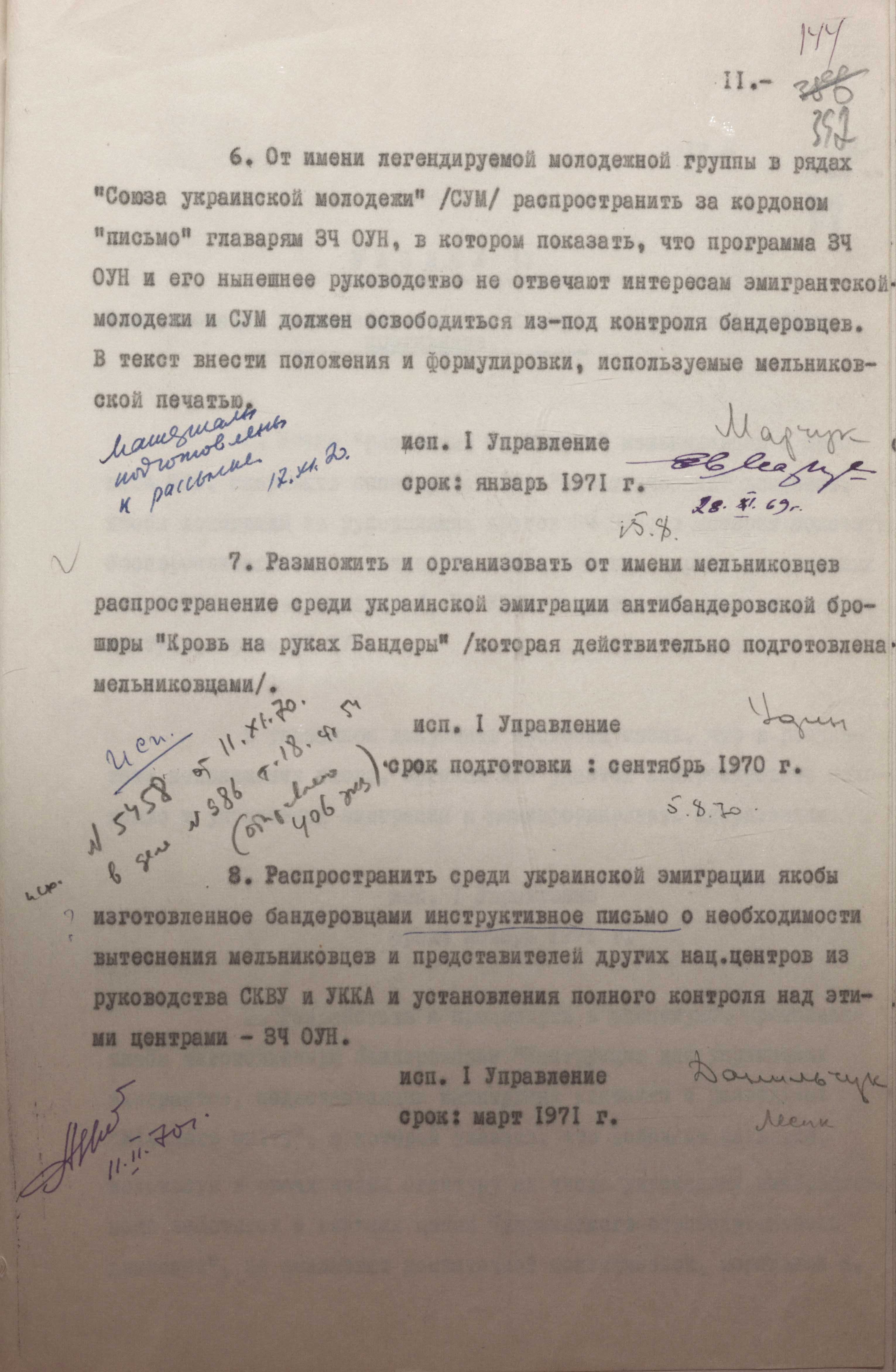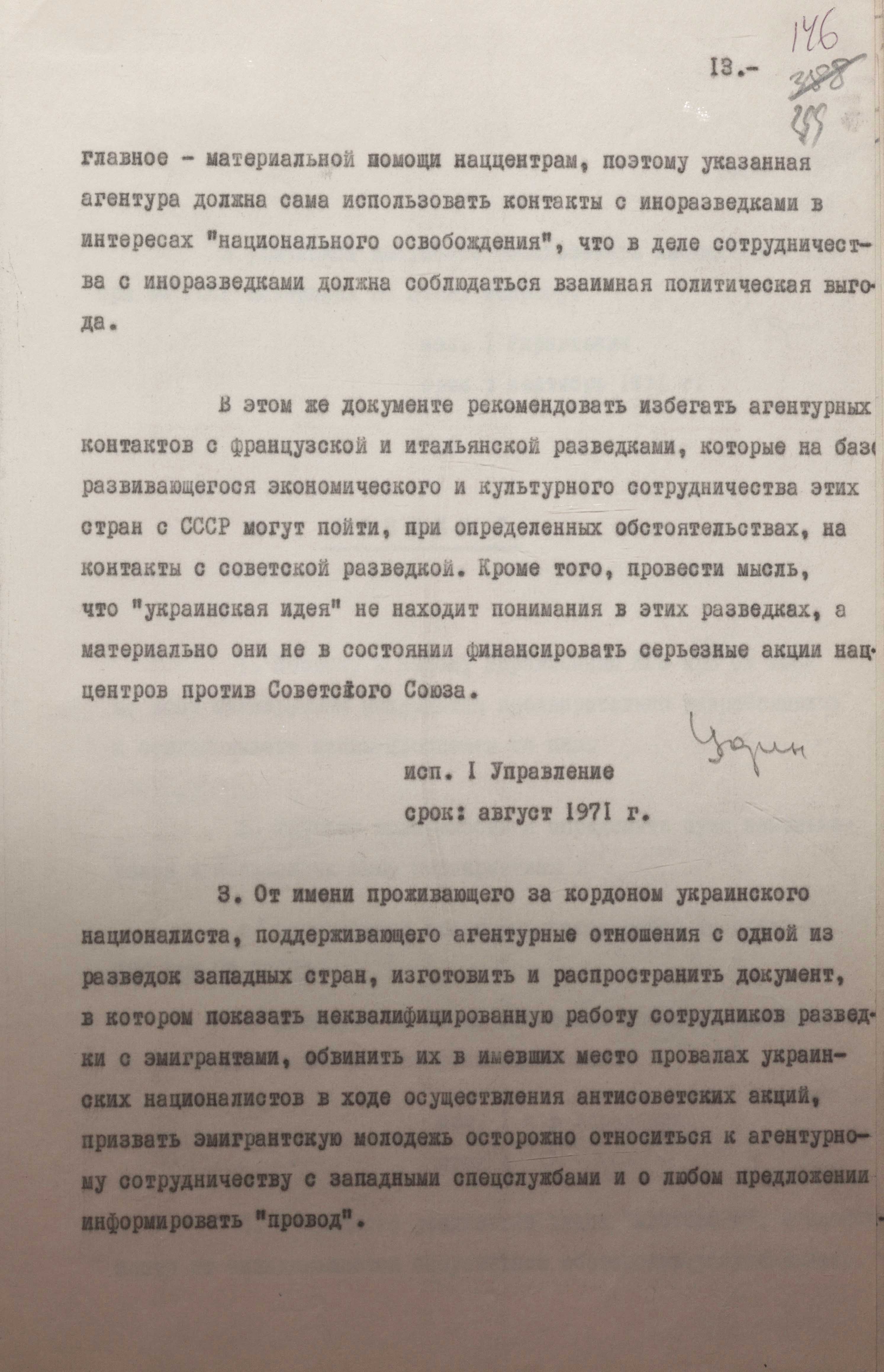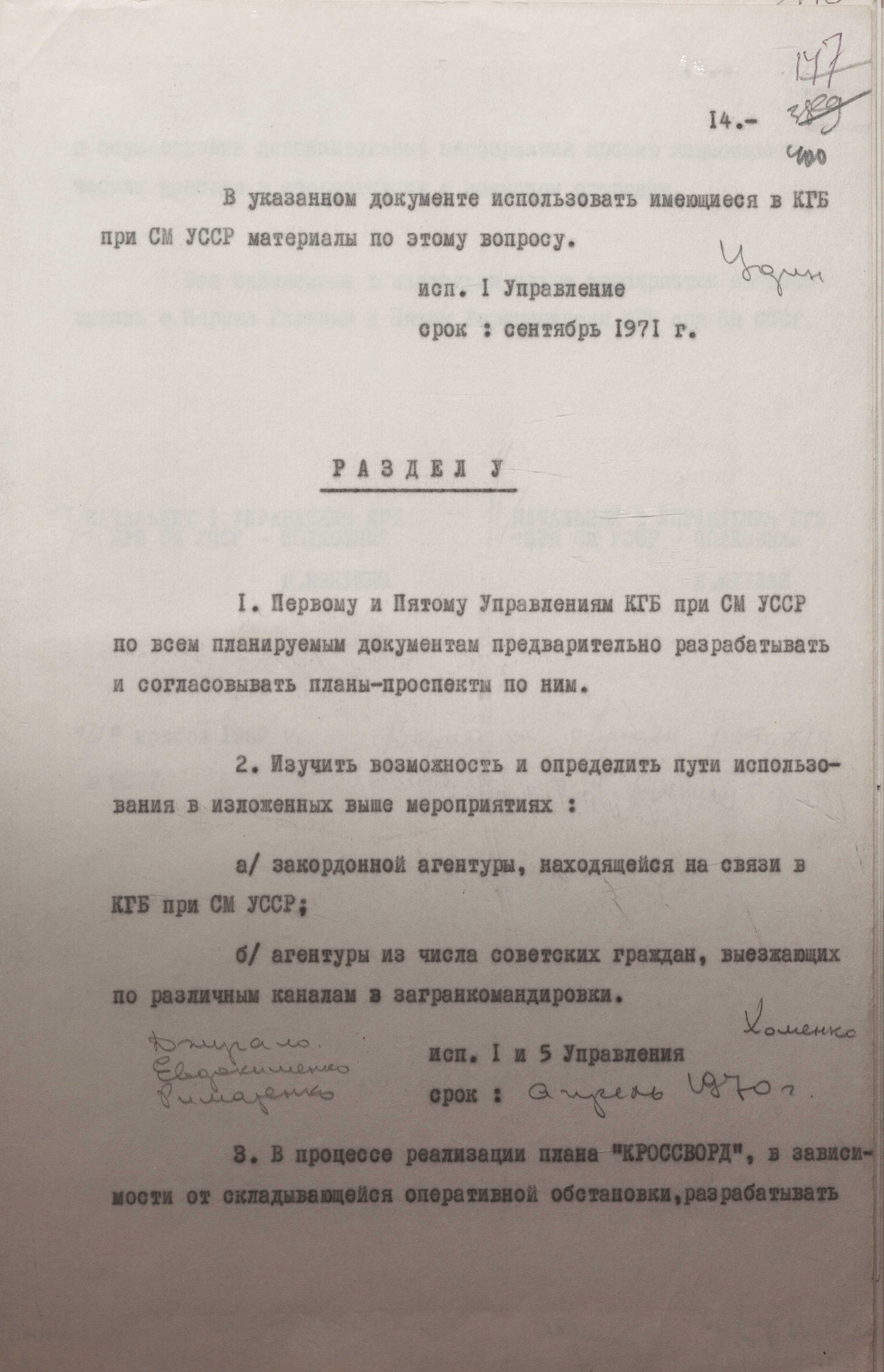“Crossword” for the OUN. The kgb’s Special Operation
6/5/2025

One of the main tasks of the kgb was to prevent unity among Ukrainian emigrant organizations. To this end, they constantly resorted to all kinds of so-called active measures. The goal was to divide Ukrainians, compromise the leaders, and eventually achieve the destruction of one or more organizations or at least a reduction in their activity. A good example of how this was developed and implemented at different stages is the kgb’s “Krossvord” (“Crossword”- Transl.) special operation against different OUN factions.
France. At the Turn of the 1970s
As evidenced by declassified documents from the archives of the Foreign Intelligence Service of Ukraine, the kgb’s special operation “Krossvord” dates back to the end of 1969. The reason for its conduction was threatening information, as interpreted by the kgb, that the Ukrainian emigrant community, particularly in France, had shown tendencies to intensify their work, as well as to reach understanding, reduce disagreements, and increase points of contact in matters of strategy and tactics of the struggle for an independent Ukraine.
One of the documents in this regard stated: “Recently, the PUN (the governing body of the Melnykites) has been calling on the “central provid” of the OUN Foreign Units (the governing body of the Banderites) to prevent mutual hostile actions and to join forces for joint anti-soviet activities. Such appeals were repeatedly made in the speeches of Head of the PUN, Oleh Shtul, at various meetings of Ukrainian nationalists both in France and abroad... In France, where the Melnykites are stronger than the Banderites, such “cooperation” is present. For example, all Ukrainian nationalist organizations participated in the preparatory work and the official opening of the Taras Shevchenko Park in Paris in the spring of 1969... The leadership of the Bandera youth organization SUM, which operates in France, is taking steps to establish contacts with the Melnyk youth organization OUMuF [Organization of Ukrainian Youth in France]. In order to coordinate the actions of Ukrainian nationalists, the Ukrainian Central Public Committee in France (UCPCF) was established several years ago. It consists of representatives of Banderites’ and Melnykites’ organizations in the country, as well as scientific, religious and other nationalist groups” (FISU.– F.1. – Case 15477. – Vol. 3. – P. 18).
Another kgb paper entitled “On the Ukrainian Nationalist Organizations’ Activities in France from June 1969 to September 1970” also referred to other joint activities that contributed to establishing unity in that way or other. They mentioned support for initiatives to erect a monument to Anna Yaroslavna, Queen of France, in Senlis, naming streets in Toulouse Ukrainian and Kyiv, making efforts to establish a Center of Ukrainian Culture and Information at the Petliura Library in Paris, establishing contacts with government officials, educational and scientific institutions, so that “foreigners can receive truthful information about Ukraine and its people.”
In addition, it was pointed out that the renewed Provid of Ukrainian Nationalists, headed by Oleh Shtul-Zhdanovych, pursued a flexible policy, called for the recognition of past mistakes and unification of all OUN factions. As a result, he allegedly managed to gain credibility and favor in nationalist circles and generally strengthen the Organization’s position.
In order to prevent such tendencies toward understanding and any unification and reconciliation, the kgb of the Ukrainian ssr decided to carry out so-called special active measures against foreign centers of Ukrainian emigration. Why was the operation called “Krossvord”? The intention was to launch various schemes vertically and horizontally in order to confuse the targets of the Chekists’ activities and to prevent anyone from solving that crossword puzzle.
On November 29, 1969, the plan for the special operation was approved by chief of the kgb of the Ukrainian ssr Vitalii Nikitchenko. The preamble to the plan stated that lately, foreign centers of Ukrainian nationalists had managed to obtain from the Ukrainian ssr “a significant amount of anti-soviet and ideologically harmful materials,” the so-called “samvydav” ([from “sam”– “self” and “vydavnytstvo”– “publication”], uncensored underground publications published and illegally distributed in the ussr – Transl.) and to have them published in controlled publishing houses. The first place in this process belongs to the OUN members of the Melnyk wing, who managed to establish a channel for smuggling works by banned authors abroad.
Representatives of other currents of the nationalist camp allegedly began to treat this activity of the Melnykites with some envy and showed increased interest in finding out how they managed to do it. This gave rise to competition for primacy and some suspicions about the ways and means of obtaining samvydav materials. It was this that the kgb decided to play on.
According to the developed plan, the result of Operation “Krossvord” had to be compromising everything and everyone, namely:
“1. “samvydav” documents, their authors and distributors.
2. OUN-s leaders through the legend of their “ties” with the kgb.
3. The OUN Foreign Units by sending specially manufactured “samvydav” materials against the Banderites to Melnykites.
4. Nationalist centers before the enemy special services as unable to properly organize illegal work on obtaining and objectively assessing information about the ussr...”
(FISU. – F.1. – Case 15477. – Vol. 2. – P. 387-389).
Declassified documents now allow us to see this kgb’s “kitchen” from the inside and understand what was really happening and why it was happening.
Compromising Samvydav Documents, Their Authors and Distributors
At that time, the kgb had agents in different centers of Ukrainian emigration, as well as among active representatives of the creative intelligentsia in soviet Ukraine. They used those opportunities to falsify certain materials, smuggle them abroad, and present them as authentic. And after they were published, move on to the next stage.
In particular, it was intended to produce and send to the Melnykites a number of samvydav (the Chekists usually put this word in quotation marks) documents on the history, literature, ethnography, science, and economy of the Ukrainian ssr that would interest them and be published. “These materials,” read the plan, “should contain factual information about the achievements of the Ukrainian people in communist construction that is favorable to us, along with points that are acceptable to nationalists. This would later be used to debunk the Melnykites as a “mouthpiece of communist propaganda”.
Further, the plan stated that in case of publication, “expanded versions of such materials, which would more fully present information favorable to us, should be sent from Paris to the UHVR’s Foreign Mission and a number of other nationalist centers in order to later accuse the Melnykites of receiving materials from the kgb, publishing them in shortened form to avoid exposure, and anonymously distributing the full texts among the general public of the Ukrainian emigration” (FISU. – F.1 – Case 15477. – V. 2. – P. 390).
The next point of the plan was to compromise Ivan Dziuba’s book “Internationalism or russification”. But how this was done! First, they prepared a critical article about the book, allegedly on behalf of the author, who held “correct” OUN positions. In the article, the author indignantly pointed out that the book essentially promoted marxist-leninist theory on the national question and that its distribution in Ukraine and abroad does more good than harm to the soviet union.
It was argued that under the influence of the book, emigrant youth would be influenced by marxist-leninist ideology and move away from nationalist centers. Finally, it was emphasized that the people who approved the book had no idea what harmful consequences for the nationalist movement could result from its uncritical perception and popularization.
However, this was only part of the insidious plan. “After the dissemination of this material abroad”, reads the plan, “ to publish in one of the emigrant publications a letter specially prepared on behalf of I. Dziuba’s “supporters” in “defense” of the book “Internationalism or Russification”. In it, under the guise of supporting I. Dziuba’s positions... to show that all “true patriots” of Ukraine understand that the “struggle” for the economic and cultural prosperity of the Ukrainian nation is possible only through further implementation of the marxist-leninist program in close alliance with the russian and other peoples of the ussr.” (FISU.– F.1. – Case 15477. – Vol. 2. – P. 391). This paragraph was accompanied by a note: agents and proxies from among writers, journalists, and scholars should be involved in the preparation of materials.
However, this was not the end of compromising samvydav and its authors. Instructions were given to prepare and disseminate an article in which the author would question the reputation of I. Dziuba, I. Svitlychnyi, V. Chornovil, Y. Sverstiuk, and other well-known and respected figures in Ukrainian emigration circles, cast a shadow over their moral character, and even suggest that the kgb was behind them and their activities.
Compromising OUN-s Leaders Through the Legend of Their “Links” with the kgb
This method of compromising active Ukrainian figures was widely used in the arsenal of the kgb. They tried to use it whenever possible. Even if it did not meet expectations, a shadow of suspicion fell on a certain person, and the kgb was happy with that.
In the “Krossvord” Operation, the kgb targeted the leader of the OUN-s (“s” stands for solidarysty as Melnykites were also known- Transl.), O. Shtul-Zhdanovych, whose activity greatly worried the chekists. They decided to prevent this. Here is how it all happened. According to archival documents, at the first stage, a former kgb officer was included in a tourist group traveling from the Ukrainian ssr to France. He was supposed to meet with O. Shtul-Zhdanovych, to give him greetings from close relatives who lived in soviet Ukraine, and at the same time, samvydav materials that had been forged in the kgb offices.
“As one of the possible options for the implementation of this measure,” said the plan, “to organize an “exposure” of the said kgb officer by a “nationalist” living in Ukraine who allegedly accidentally learnt about his meeting with Shtul-Zhdanovych” (FISU – F.1. – Case 15477. – Vol. 2. – P. 391).
It went on to say that the kgb had O. Shtul-Zhdanovych’s letters to his father. Therefore, they planned to forge several new letters in the same handwriting in which he would speak negatively about the Banderites. Besides, the letter contained a veiled request for his father to give his greetings to certain secretive individuals (meaning kgb officers). And to recommend them to periodically publish articles against him in the republican press in order to allegedly remove all suspicions and establish the image of a dedicated fighter against the soviet regime.
At the final stage of the plan, the task was to publish those forged letters with relevant comments, and on the basis of that, to prepare and spread abroad on behalf of the Banderites a number of articles against O. Shtul-Zhdanovych and the organization he led, accusing him of having ties to the kgb. According to the materials of the declassified case file on O. Shtul-Zhdanovych, all points of the plan were fulfilled. The case file contains forged letters, recommendations on how and what to write in them, and other kgb’s operational schemes to compromise the leader of the Provid of Ukrainian Nationalists.
Another feature of such measures was their duration. According to archival documents, the kgb’s active measures against O. Shtul-Zhdanovych within the framework of Operation “Krossvord” had been carried out for years. This is confirmed by the document “On the Work Against the OUN-s”, dated 1973. It stated that during the previous year (1972), measures were taken to compromise “Osyp” (the operational codename given to him by the chekists), as a result of which the Banderites began to attack him in their newspapers as a kgb agent.
“Over the next 2-3 years,” the paper continued, “it is planned to prepare and carry out the following agent-operational activities:
Further measures to compromise “Osyp” should lead to his removal from the post of the head of the OUN at the upcoming, in 1973, 8th meeting of the OUN-s and psychological pressure on him.
To this end, prepare:
- a leaflet on behalf of the Banderites demanding to remove Osyp from his post;
- a letter on behalf of the Banderites to “Osyp” with threats of physical violence against him;
- a series of articles for the newspaper “Visti z Ukrainy” exposing the anti-people activities of the OUN-s and its leaders, including “Osyp”, followed by manufacturing and spreading among the emigrants an anonymous letter, in which those articles should be called the kgb’s attempt to deflect the threat from its agent;
- an anonymous letter from Banderites stating that “Osyp” was allegedly preparing to escape to the ussr...”
(FISU.– F.1. – Case 15477. – Vol. – 3. P. 138-139)
As a result of those measures, the kgb sought to achieve a dual goal: to compromise the leader of the OUN-s and to incite enmity between this organization and the Banderites.
Compromising the OUN-s Foreign Units by Sending Specially Manufactured Samvydav Materials Against the Banderites to Melnykites.
The measures envisaged by this part of the plan were intended to finally put Melnykites at odds with the Banderites. For this purpose, under the guise of samvydav, the kgb prepared texts allegedly authored by PUN supporters, which criticized the programmatic provisions of the documents of regular meetings and conferences of the OUN Central Committee. On behalf of the political opponents of the Banderites, they planned to spread several documents abroad to compromise personally Y. Stetsko, S. Lenkivskyi and other leaders of the OUN Foreign Units.
One of the points of the plan was to prepare a document entitled “Testament to the Fighters,” in which, on behalf of one of the former insurgent leaders, to analyze his life in the underground, to admit that his entire period in the ranks of the Banderites was a mistake, and to show that the armed struggle of S. Bandera and his inner circle against the soviet power was wrong and unnecessary.
Or another point of the plan:
“On behalf of the mythical youth group in the ranks of the Union of Ukrainian Youth (SUM), to distribute abroad a “letter” from the leader of Foreign Units of the OUN, in which to show that the program of the Foreign Units of the OUN and its current leadership does not meet the interests of emigrant youth and the SUM should get rid of the influence of the Banderites. In the text, use the provisions and wording used in the Melnykites’ press” (FISU. – F.1. – Case 15477. – Vol. 2. – P. 397).
Compromising Nationalist Centers in the Eyes of the Enemy’s Special Services
According to declassified documents, the kgb aimed not only to discredit individual Ukrainian figures, to split different factions of Ukrainian emigration, to prevent unification, to compromise samvydav, but also to make Western governments and their special services stop supporting the liberation movement and the struggle to restore Ukraine’s independence. Special measures were also developed for this purpose.
In particular, within the framework of Operation “Krossvord”, it was planned “after the ‘disclosure of contacts’ of Melnykites with the kgb, to send to the US intelligence services an ‘analytical’ document that allegedly leaked out of the leadership circles of the OUN Foreign Units. The document should show the futility and danger of using the OUN-s (Melnykites), the UHVR’s Foreign Mission and other nationalist centers (except for the OUN Foreign Units) for intelligence purposes” (FISU. – F.1. – Case 15477. – Vol. 2. – P. 398).
Among other things, the task was to create an “Instruction for Ukrainian Emigrants Who Maintain Agent Contacts with Intelligence Services of the ‘Free World’”, which would contain provisions and recommendations to compromise special services and the very idea of receiving assistance from them in the liberation struggle. This pseudo-instruction was also to come in view of a number of intelligence services, so that they would give up such contacts. In other words, it was about isolating Ukrainian centers abroad from any kind of assistance from the outside.
The range of methods was diverse. Along with incriminating documents (in fact, falsified) about anti-soviet organizations’ cooperation with Western intelligence, the kgb practiced confession interviews with agents, press conferences with the participation of specially trained persons, and so on. Many points of the plan are marked “prepared,” “executed,” “manufactured” and “spread”.
It was not easy to solve such “crosswords” and recognize all kinds of kgb’s combinations. At the same time, as evidenced by the clippings from emigrant newspapers included in the case files, Ukrainian activists were not gullible and defenseless and resisted provocations.
In 1971, the newspaper “Shlyakh Peremohy” wrote about this: “Moscow’s agentura keeps spreading provocative brochures and leaflets anonymously. The kgb provocateurs often try to do this as if Ukrainian political environments were doing it against their opponents. However, due to a lack of proper knowledge, provocateurs always make a mistake that shows the face of the provocateurs. It must be stated that every political emigrant already knows the methods of the kgb, and the provocateurs’ attempts to create tension are unsuccessful...”
Thus, although the kgb reported that Operation “krossvord” was successful, not everything went according to plan. In particular, despite all the expectations of the chekists, in 1974 O. Shtul-Zhdanovych was elected Head of the Provid of Ukrainian Nationalists for the third time. And he did not change his beliefs and intentions to fight for Ukraine’s independence, for unity among Ukrainians, and moreover, he became one of the co-founders of the World Congress of Free Ukrainians.
